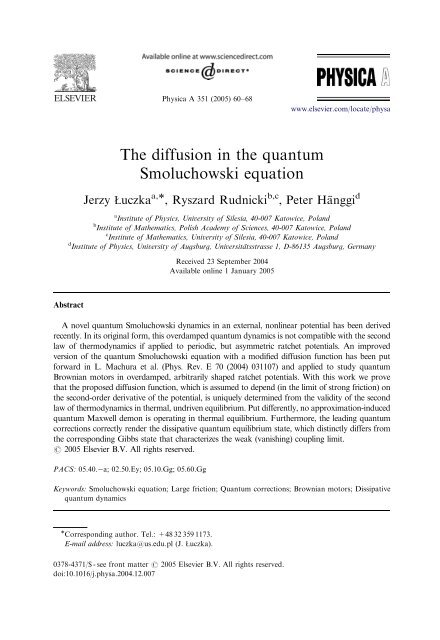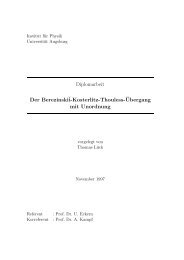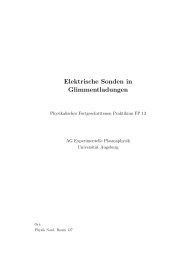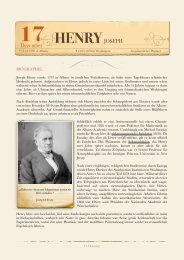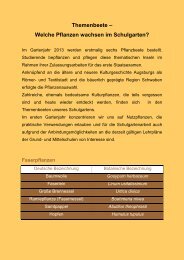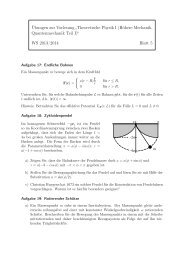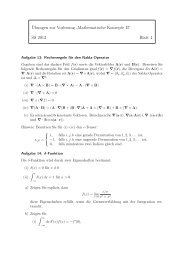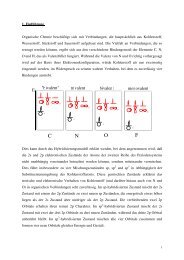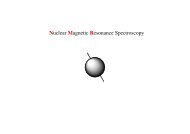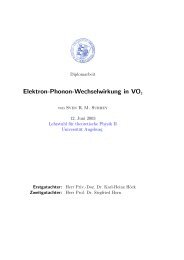The diffusion in the quantum Smoluchowski equation
The diffusion in the quantum Smoluchowski equation
The diffusion in the quantum Smoluchowski equation
Create successful ePaper yourself
Turn your PDF publications into a flip-book with our unique Google optimized e-Paper software.
ARTICLE IN PRESS<br />
Physica A 351 (2005) 60–68<br />
www.elsevier.com/locate/physa<br />
<strong>The</strong> <strong>diffusion</strong> <strong>in</strong> <strong>the</strong> <strong>quantum</strong><br />
<strong>Smoluchowski</strong> <strong>equation</strong><br />
Jerzy Łuczka a, , Ryszard Rudnicki b,c , Peter Ha¨ nggi d<br />
a Institute of Physics, University of Silesia, 40-007 Katowice, Poland<br />
b Institute of Ma<strong>the</strong>matics, Polish Academy of Sciences, 40-007 Katowice, Poland<br />
c Institute of Ma<strong>the</strong>matics, University of Silesia, 40-007 Katowice, Poland<br />
d Institute of Physics, University of Augsburg, Universitätsstrasse 1, D-86135 Augsburg, Germany<br />
Received 23 September 2004<br />
Available onl<strong>in</strong>e 1 January 2005<br />
Abstract<br />
A novel <strong>quantum</strong> <strong>Smoluchowski</strong> dynamics <strong>in</strong> an external, nonl<strong>in</strong>ear potential has been derived<br />
recently. In its orig<strong>in</strong>al form, this overdamped <strong>quantum</strong> dynamics is not compatible with <strong>the</strong> second<br />
law of <strong>the</strong>rmodynamics if applied to periodic, but asymmetric ratchet potentials. An improved<br />
version of <strong>the</strong> <strong>quantum</strong> <strong>Smoluchowski</strong> <strong>equation</strong> with a modified <strong>diffusion</strong> function has been put<br />
forward <strong>in</strong> L. Machura et al. (Phys. Rev. E 70 (2004) 031107) and applied to study <strong>quantum</strong><br />
Brownian motors <strong>in</strong> overdamped, arbitrarily shaped ratchet potentials. With this workwe prove<br />
that <strong>the</strong> proposed <strong>diffusion</strong> function, which is assumed to depend (<strong>in</strong> <strong>the</strong> limit of strong friction) on<br />
<strong>the</strong> second-order derivative of <strong>the</strong> potential, is uniquely determ<strong>in</strong>ed from <strong>the</strong> validity of <strong>the</strong> second<br />
law of <strong>the</strong>rmodynamics <strong>in</strong> <strong>the</strong>rmal, undriven equilibrium. Put differently, no approximation-<strong>in</strong>duced<br />
<strong>quantum</strong> Maxwell demon is operat<strong>in</strong>g <strong>in</strong> <strong>the</strong>rmal equilibrium. Fur<strong>the</strong>rmore, <strong>the</strong> lead<strong>in</strong>g <strong>quantum</strong><br />
corrections correctly render <strong>the</strong> dissipative <strong>quantum</strong> equilibrium state, which dist<strong>in</strong>ctly differs from<br />
<strong>the</strong> correspond<strong>in</strong>g Gibbs state that characterizes <strong>the</strong> weak(vanish<strong>in</strong>g) coupl<strong>in</strong>g limit.<br />
r 2005 Elsevier B.V. All rights reserved.<br />
PACS: 05.40.<br />
a; 02.50.Ey; 05.10.Gg; 05.60.Gg<br />
Keywords: <strong>Smoluchowski</strong> <strong>equation</strong>; Large friction; Quantum corrections; Brownian motors; Dissipative<br />
<strong>quantum</strong> dynamics<br />
Correspond<strong>in</strong>g author. Tel.: +48 32 359 1173.<br />
E-mail address: luczka@us.edu.pl (J. Łuczka).<br />
0378-4371/$ - see front matter r 2005 Elsevier B.V. All rights reserved.<br />
doi:10.1016/j.physa.2004.12.007
ARTICLE IN PRESS<br />
J. Łuczka et al. / Physica A 351 (2005) 60–68 61<br />
1. Introduction<br />
In classical statistical physics, <strong>the</strong> description of a system coupled to <strong>the</strong>rmal bath<br />
of temperature T is formulated <strong>in</strong> terms of Langev<strong>in</strong>-type <strong>equation</strong>s and<br />
correspond<strong>in</strong>g Fokker–Planck or master <strong>equation</strong>s [1,2]. This scheme models <strong>the</strong><br />
phenomenon of Brownian motion, a phenomenon that has been described<br />
<strong>the</strong>oretically by <strong>the</strong> two ‘‘grandfa<strong>the</strong>rs’’ of Brownian motion: Albert E<strong>in</strong>ste<strong>in</strong> and<br />
Marian von <strong>Smoluchowski</strong> [3,4]. For a classical Brownian particle mov<strong>in</strong>g <strong>in</strong> an<br />
external field, <strong>the</strong> statistical properties are described by <strong>the</strong> Kle<strong>in</strong>–Kramers <strong>equation</strong><br />
<strong>in</strong> <strong>the</strong> phase space of position and momentum degree of freedom [1,2,5]. In <strong>the</strong><br />
strong friction limit it reduces to <strong>the</strong> so-called <strong>Smoluchowski</strong> <strong>equation</strong> <strong>in</strong> position<br />
space alone [6]. <strong>The</strong> issue of <strong>quantum</strong> Brownian motion is more subtle [7]. In this<br />
context, it is important to note that for a correct description of <strong>the</strong> <strong>quantum</strong><br />
dynamics of <strong>the</strong> subsystem, <strong>the</strong> Brownian particle must at all times be consistent with<br />
<strong>the</strong> Heisenberg pr<strong>in</strong>ciple and <strong>the</strong> commutator structure of <strong>quantum</strong> dynamics; as a<br />
consequence, <strong>the</strong> reduced dynamics modeled <strong>in</strong> <strong>the</strong> form of a correspond<strong>in</strong>g<br />
<strong>quantum</strong> Langev<strong>in</strong> <strong>equation</strong> must necessarily operate <strong>in</strong> <strong>the</strong> total Hilbert space of<br />
<strong>the</strong> system dynamics (i.e., <strong>the</strong> particle) and <strong>the</strong> <strong>the</strong>rmal bath degrees of freedom.<br />
Given an <strong>in</strong>itial preparation scheme [8], a consistent statistical description is also<br />
possible as well <strong>in</strong> terms of (generalized) <strong>quantum</strong> master <strong>equation</strong>s for <strong>the</strong> reduced<br />
density operator of <strong>the</strong> system dynamics alone, i.e., <strong>the</strong> <strong>quantum</strong> Brownian<br />
dynamics. An example constitutes <strong>the</strong> weakcoupl<strong>in</strong>g limit, for which <strong>quantum</strong><br />
master <strong>equation</strong>s (e.g. of L<strong>in</strong>dblad form) have been derived [9]. <strong>The</strong> strong friction<br />
limit has only recently attracted <strong>in</strong>terest. Different approaches have been proposed<br />
<strong>in</strong> <strong>the</strong> recent years that are seem<strong>in</strong>gly not wholly consistent with each o<strong>the</strong>r [10].<br />
Here, we follow <strong>the</strong> scheme that is rigorously based on a path <strong>in</strong>tegral formulation of<br />
<strong>the</strong> (reduced) <strong>quantum</strong> Brownian motion [5,7].<br />
Follow<strong>in</strong>g Ankerhold–Pechukas–Grabert [11], <strong>the</strong> limit of strong friction can be<br />
described by a correspond<strong>in</strong>g <strong>quantum</strong> <strong>Smoluchowski</strong> dynamics conta<strong>in</strong><strong>in</strong>g lead<strong>in</strong>g<br />
<strong>quantum</strong> corrections. For a particle of mass M mov<strong>in</strong>g <strong>in</strong> <strong>the</strong> potential VðxÞ; such a<br />
<strong>quantum</strong> <strong>Smoluchowski</strong> <strong>equation</strong> has been derived for <strong>the</strong> diagonal part of <strong>the</strong><br />
density operator rðtÞ; i.e., for <strong>the</strong> probability density Pðx; tÞ ¼hxjrðtÞjxi <strong>in</strong> <strong>the</strong><br />
position space x. It explicitly reads [11]<br />
gM q qt<br />
q<br />
Pðx; tÞ ¼<br />
qx V 0 q2<br />
eff ðxÞPðx; tÞþ<br />
qx 2 D eff ðxÞPðx; tÞ ; (1)<br />
where g is a friction coefficient. <strong>The</strong> effective potential reads<br />
V eff ðxÞ ¼VðxÞþð1=2ÞlV 00 ðxÞ ; (2)<br />
where<strong>in</strong> <strong>the</strong> prime denotes <strong>the</strong> derivative with respect to <strong>the</strong> coord<strong>in</strong>ate x. <strong>The</strong><br />
effective <strong>diffusion</strong> coefficient<br />
D eff ðxÞ ¼D 1 ðxÞ ¼ 1 b ½1 þ lbV 00 ðxÞŠ (3)
ARTICLE IN PRESS<br />
62<br />
J. Łuczka et al. / Physica A 351 (2005) 60–68<br />
both <strong>in</strong>cludes lead<strong>in</strong>g <strong>quantum</strong> corrections described by <strong>the</strong> (<strong>quantum</strong>)-parameter<br />
l ¼ð_=pMgÞ lnð_bg=2pÞ; b ¼ 1=k B T (4)<br />
and k B is <strong>the</strong> Boltzmann constant. <strong>The</strong> parameter l is nonl<strong>in</strong>ear with respect to <strong>the</strong><br />
Planckconstant _ and measures typical <strong>quantum</strong> fluctuations <strong>in</strong> <strong>the</strong> position space<br />
[11,12]. Note that at strong friction, <strong>the</strong> lead<strong>in</strong>g <strong>quantum</strong> corrections vanish for<br />
(biased) free <strong>quantum</strong>-Brownian motion, i.e., for potentials with VðxÞ ¼const; or<br />
with l<strong>in</strong>ear VðxÞ ¼ax; <strong>in</strong> <strong>the</strong> two latter cases no normalizable stationary state occurs.<br />
<strong>The</strong> validity regime for Eq. (1) is <strong>in</strong> <strong>the</strong> <strong>quantum</strong> <strong>Smoluchowski</strong> regime when<br />
lb1=Mbg 2 and k B T5_g [11]. Note that formally l diverges at zero temperature;<br />
it is thus important to note that <strong>the</strong> limit b !1 should be taken only after <strong>the</strong><br />
limit g !1:<br />
This <strong>equation</strong> assumes <strong>the</strong> form—with<strong>in</strong> <strong>the</strong> regime of validity with D eff 40—of a<br />
classical <strong>Smoluchowski</strong> <strong>equation</strong> with state-dependent <strong>diffusion</strong>. Thus, it <strong>in</strong>tr<strong>in</strong>sically<br />
obeys detailed balance for all conf<strong>in</strong><strong>in</strong>g potentials V eff ðxÞ obey<strong>in</strong>g V eff ðx !<br />
Þ ¼ 1: Put differently, for unbounded, conf<strong>in</strong><strong>in</strong>g potentials this one-dimensional<br />
<strong>Smoluchowski</strong> <strong>equation</strong> obeys formally detailed balance. This situation changes,<br />
however, for <strong>the</strong> class of bounded potentials. For example, <strong>in</strong> a periodic potential<br />
V eff ðxÞ; <strong>the</strong> second law of <strong>the</strong>rmodynamics implies that no stationary current is<br />
supported. This is <strong>the</strong> case if detailed balance also holds for <strong>the</strong> class of such periodic<br />
potentials, or more generally, for bounded potentials.<br />
It is thus a nontrivial observation that—upon <strong>in</strong>spection—<strong>the</strong> above <strong>Smoluchowski</strong><br />
<strong>equation</strong> <strong>in</strong>deed does not obey <strong>the</strong> second law of <strong>the</strong>rmodynamics for<br />
periodic potentials. Indeed, let us consider a periodic potential VðxÞ ¼Vðx þ LÞ of<br />
period L. From Eq. (1), follow<strong>in</strong>g <strong>the</strong> reason<strong>in</strong>g of Stratonovich [13], but generalized<br />
here to state-dependent <strong>diffusion</strong>, see [14], <strong>the</strong> stationary drift velocity hvi of <strong>the</strong><br />
particle emerges as<br />
hvi ¼ L<br />
gM<br />
1 exp½CðLÞŠ<br />
R L<br />
0 D 1 1ðxÞ<br />
exp½ CðxÞŠ R xþL<br />
x<br />
exp½CðyÞŠ dy dx<br />
with <strong>the</strong> generalized <strong>the</strong>rmodynamic potential given by<br />
Z x V 0 eff<br />
CðxÞ ¼<br />
ðyÞ<br />
dy : (6)<br />
0 D eff ðyÞ<br />
If <strong>the</strong> periodic potential is asymmetric, e.g., VðxÞ ¼cosð2pxÞþð1=4Þ s<strong>in</strong>ð4pxÞ; and<br />
L ¼ 1; <strong>the</strong> generalized <strong>the</strong>rmodynamic potential CðLÞa0: Consequently, a nonzero<br />
stationary drift velocity occurs <strong>in</strong> <strong>the</strong> <strong>the</strong>rmal equilibrium state, i.e., an approximation-<strong>in</strong>duced<br />
<strong>quantum</strong> Maxwell demon [15] is seem<strong>in</strong>gly at work.<br />
(5)<br />
2. Diffusion function<br />
In <strong>the</strong> recent work [16], we have proposed an improved <strong>quantum</strong> <strong>Smoluchowski</strong><br />
<strong>equation</strong>, <strong>in</strong> which <strong>the</strong> effective potential V eff ðxÞ is <strong>the</strong> same as <strong>in</strong> (2) but <strong>the</strong><br />
<strong>diffusion</strong> function D eff ðxÞ is modified <strong>in</strong> such a way that <strong>the</strong> modified <strong>Smoluchowski</strong>
<strong>equation</strong> no longer causes such a perpetual motion phenomenon. This new <strong>quantum</strong><br />
<strong>Smoluchowski</strong> dynamics is subject to <strong>the</strong> follow<strong>in</strong>g construction criteria:<br />
(i) Remedy <strong>the</strong> <strong>diffusion</strong> function to obey CðLÞ 0 for any periodic potential<br />
VðxÞ:<br />
(ii) Assume that <strong>the</strong> <strong>diffusion</strong> function is a function F of <strong>the</strong> second-order derivative<br />
of VðxÞ; i.e., D eff ðxÞ ¼F½V 00 ðxÞŠ; as <strong>in</strong> (3).<br />
(iii) For <strong>the</strong> harmonic oscillator, <strong>the</strong> position equilibrium probability emerg<strong>in</strong>g from<br />
(1) should co<strong>in</strong>cide at strong friction with <strong>the</strong> exact distribution [17].<br />
Condition (ii) may seem to be restrictive: <strong>the</strong> unknown <strong>diffusion</strong> function could depend<br />
functionally not only on V 00 ðxÞ; but also on higher order derivatives of <strong>the</strong> potential.<br />
However, if we take <strong>in</strong>to account <strong>the</strong> lead<strong>in</strong>g <strong>quantum</strong> corrections <strong>in</strong> <strong>the</strong> asymptotic<br />
strong friction limit, such higher order derivatives of VðxÞ can safely be neglected.<br />
Next, from <strong>the</strong> first two conditions we obta<strong>in</strong><br />
Z L<br />
V 0 ðxÞþð1=2ÞlV 000 ðxÞ<br />
0 F½V 00 dx ¼ 0 : (7)<br />
ðxÞŠ<br />
<strong>The</strong> second part of <strong>the</strong> <strong>in</strong>tegral, which conta<strong>in</strong>s <strong>the</strong> contribution V 000 ðxÞ; is zero for<br />
arbitrary periodic functions VðxÞ and functions F½V 00 ðxÞŠ; for which <strong>the</strong> <strong>in</strong>tegral<br />
exists. Indeed, upon a change <strong>in</strong> <strong>the</strong> <strong>in</strong>tegration variable x to <strong>the</strong> new variable<br />
y ¼ V 00 ðxÞ; and a partition of <strong>the</strong> <strong>in</strong>terval ½0; LŠ <strong>in</strong>to a sum of sub<strong>in</strong>tervals, on which<br />
<strong>the</strong> function V 00 ðxÞ is monotonic, we f<strong>in</strong>d that this second contribution is<br />
proportional to<br />
X n 1 Z yiþ1<br />
i¼0<br />
y i<br />
ð1=FðyÞÞdy ¼ Xn 1<br />
ARTICLE IN PRESS<br />
J. Łuczka et al. / Physica A 351 (2005) 60–68 63<br />
i¼0<br />
AðyÞj y iþ1<br />
y i<br />
¼ Aðy n Þ Aðy 0 Þ¼AðV 00 ðLÞÞ AðV 00 ð0ÞÞ ¼ 0 ; ð8Þ<br />
because V 00 ðxÞ is periodic and V 00 ð0Þ ¼V 00 ðLÞ: <strong>The</strong> first position is y 0 ¼ V 00 ð0Þ; <strong>the</strong><br />
last one is y n ¼ V 00 ðLÞ; and <strong>the</strong> rema<strong>in</strong><strong>in</strong>g positions are y i ¼ V 00 ðx i Þ; where <strong>the</strong> set of<br />
positions x i are positions of extremal values of <strong>the</strong> function V 00 ðxÞ: <strong>The</strong> function AðyÞ<br />
denotes <strong>the</strong> anti-derivative (i.e., <strong>the</strong> <strong>in</strong>tegral) of 1=FðyÞ: <strong>The</strong>refore, condition (7)<br />
becomes equivalent to<br />
Z L<br />
V 0 ðxÞ<br />
0 FðV 00 dx ¼ 0 : (9)<br />
ðxÞÞ<br />
With this workwe show that <strong>the</strong>re is <strong>in</strong>deed only one function FðyÞ; for which<br />
condition (9) is obeyed for an arbitrary periodic potential VðxÞ ¼Vðx þ LÞ: In our<br />
proof, we use <strong>the</strong> well-known functional method familiar from <strong>the</strong>oretical mechanics:<br />
among all possible trajectories, f<strong>in</strong>d <strong>the</strong> one for which <strong>the</strong> functional (called <strong>the</strong> action)<br />
is extremal. Our taskcan be formulated as follows: among all possible functions<br />
FðV 00 ðxÞÞ; f<strong>in</strong>d <strong>the</strong> one for which (9) is fulfilled. To this goal, let us denote<br />
f ðxÞ ¼V 0 ðxÞ; GðyÞ ¼1=FðyÞ : (10)
ARTICLE IN PRESS<br />
64<br />
J. Łuczka et al. / Physica A 351 (2005) 60–68<br />
Condition (9) <strong>the</strong>n takes on <strong>the</strong> form<br />
Z L<br />
0<br />
Gðf 0 ðxÞÞf ðxÞ dx ¼ 0 : (11)<br />
Let X be a set of L-periodic functions f : R ! R such that R L<br />
0<br />
f ðxÞ dx ¼ 0: Moreover,<br />
ma<strong>in</strong>ly for technical reasons, we assume from here on that f 2 C 3 : Next, we derive <strong>the</strong><br />
follow<strong>in</strong>g <strong>the</strong>orem:<br />
<strong>The</strong>orem 1. Let G : R ! R be a three times differentiable function with cont<strong>in</strong>uous<br />
derivative G 000 : If (11) holds for every f 2 X; <strong>the</strong>n G is a l<strong>in</strong>ear function, i.e., GðyÞ ¼<br />
a þ by:<br />
Proof. Consider a functional S on X given by <strong>the</strong> expression<br />
Sðf Þ¼<br />
Z L<br />
0<br />
Gðf 0 ðxÞÞf ðxÞ dx : (12)<br />
<strong>The</strong>n, from (11) it follows that <strong>the</strong> functional Sðf Þ is constant and its <strong>in</strong>crement<br />
Sðf þ hÞ Sðf Þ¼0 for every f 2 X and h 2 X; this implies that <strong>the</strong> functional<br />
derivative ðdS=df ÞðhÞ ¼0; i.e., by use of <strong>the</strong> notation Gðf 0 ðxÞÞ ¼ ðG f 0 ÞðxÞ we obta<strong>in</strong><br />
Z<br />
dS<br />
L<br />
df ðhÞ ¼ ½ðG 0 f 0 ÞðxÞf ðxÞh 0 ðxÞþðG f 0 ÞðxÞhðxÞŠ dx (13)<br />
0<br />
¼ðG 0 f 0 ÞðLÞf ðLÞhðLÞ ðG 0 f 0 Þð0Þf ð0Þhð0Þ (14)<br />
þ<br />
Z L<br />
0<br />
fðG f 0 ÞðxÞ ½ðG 0 f 0 ÞðxÞf ðxÞŠ 0 ghðxÞ dx : (15)<br />
S<strong>in</strong>ce f ð0Þ ¼f ðLÞ; hð0Þ ¼hðLÞ and f 0 ðLÞ ¼f 0 ð0Þ; one f<strong>in</strong>ds<br />
Z L<br />
dS<br />
df ðhÞ ¼<br />
0<br />
cðxÞhðxÞ dx ¼ 0 ; (16)<br />
where<br />
cðxÞ ¼½ðG 0 f 0 ÞðxÞf ðxÞŠ 0 ðG f 0 ÞðxÞ : (17)<br />
Given <strong>the</strong> proposition proved <strong>in</strong> <strong>the</strong> appendix it follows that c const: Next, let f a;m<br />
be a family of functions from <strong>the</strong> set X such that f a;m ðyÞ ¼ m 2 y2 þ a; a 2 R; m 2 R; for<br />
y 2ð L 3 ; 2L 3 Þ: After substitut<strong>in</strong>g f a;m <strong>in</strong>to (17) we obta<strong>in</strong><br />
h <br />
G 0 ðmyÞ m i 0<br />
2 y2 þ a GðmyÞ const ; (18)<br />
and consequently<br />
amG 00 ðmyÞþ m2<br />
2 y2 G 00 ðmyÞþmyG 0 ðmyÞ GðmyÞ const : (19)<br />
S<strong>in</strong>ce <strong>the</strong> left-hand side of this <strong>equation</strong> is constant for arbitrary a; we conclude that<br />
G 00 ðmyÞ const for my 2ð mL 3 ; 2mL<br />
3 Þ: S<strong>in</strong>ce m is an arbitrary constant we have G00 const
on <strong>the</strong> whole R: Consequently,<br />
ARTICLE IN PRESS<br />
J. Łuczka et al. / Physica A 351 (2005) 60–68 65<br />
1<br />
2 ðmyÞ2 G 00 ðmyÞþmyG 0 ðmyÞ GðmyÞ const (20)<br />
for y 2ð L 3 ; 2L 3<br />
Þ: S<strong>in</strong>ce m is an arbitrary constant we also obta<strong>in</strong> that<br />
1<br />
2 y2 G 00 ðyÞþyG 0 ðyÞ GðyÞ const (21)<br />
for y 2 R: With <strong>the</strong> result G 00 ¼ const; it thus follows uniquely that GðyÞ ¼a þ by þ<br />
cy 2 ; where a; b; c 2 R: Insertion of GðyÞ <strong>in</strong>to (21) yields c ¼ 0: As a ma<strong>in</strong> result we<br />
obta<strong>in</strong> GðyÞ ¼a þ by; <strong>the</strong>reby complet<strong>in</strong>g <strong>the</strong> proof.<br />
3. Discussion and conclusion<br />
Given <strong>The</strong>orem 1, it follows that <strong>the</strong> sought-after <strong>diffusion</strong> function F <strong>in</strong> (9)<br />
assumes <strong>the</strong> form<br />
F½V 00 1<br />
ðxÞŠ ¼<br />
a þ bV 00 ðxÞ ; (22)<br />
with arbitrary constants a and b. <strong>The</strong>se two constants can be determ<strong>in</strong>ed as follows:<br />
expand (22) <strong>in</strong>to a series. <strong>The</strong>n for a ¼ b and b ¼ lb 2 ; <strong>the</strong> <strong>diffusion</strong> functions (3)<br />
and (22) co<strong>in</strong>cide to <strong>the</strong> first order with respect to <strong>the</strong> quantity ðxÞ ¼jlbV 00 ðxÞjo1:<br />
For smooth periodic functions VðxÞ; this <strong>in</strong>equality can be fulfilled for arbitrary x<br />
and sufficiently small lb: Note that, V 00 ðxÞ is bounded for arbitrary x and <strong>the</strong><br />
convergence of (22) to Eq. (3) is uniform. Given <strong>the</strong> above f<strong>in</strong>d<strong>in</strong>gs, we propose a<br />
new <strong>quantum</strong> <strong>Smoluchowski</strong> <strong>equation</strong> (1) with <strong>the</strong> modified <strong>diffusion</strong> function<br />
read<strong>in</strong>g<br />
1<br />
D eff ðxÞ ¼D 2 ðxÞ ¼<br />
b½1 lbV 00 ðxÞŠ ; (23)<br />
which must be <strong>in</strong>terpreted as <strong>the</strong> lead<strong>in</strong>g, nonperturbative, asymptotic large friction<br />
result.<br />
In conclusion, <strong>the</strong> above <strong>quantum</strong> stochastic dynamics becomes, <strong>in</strong> this strong<br />
friction limit equivalent to a classical, overdamped Brownian dynamics <strong>in</strong> <strong>the</strong><br />
effective potential (2) and with a state-dependent <strong>diffusion</strong> coefficient (23). <strong>The</strong><br />
correspond<strong>in</strong>g classical Langev<strong>in</strong> <strong>equation</strong> reads <strong>in</strong> <strong>the</strong> Ito-representation [1]<br />
pffiffiffiffiffiffiffiffiffiffiffiffiffiffiffiffiffiffiffiffiffi<br />
gM _x ¼ V 0 eff ðxÞþ 2gMD 2 ðxÞxðtÞ ; (24)<br />
where <strong>the</strong> dot denotes <strong>the</strong> time derivative and xðtÞ is classical Gaussian white noise of<br />
vanish<strong>in</strong>g mean and correlation hxðtÞxðsÞi ¼ dðt sÞ:<br />
Our result for <strong>the</strong> <strong>quantum</strong> <strong>Smoluchowski</strong> <strong>equation</strong> resembles <strong>in</strong> spirit <strong>the</strong><br />
problem of model<strong>in</strong>g colored (or correlated) noise <strong>in</strong> classical, nonl<strong>in</strong>ear stochastic<br />
physics <strong>in</strong> terms of an effective Fokker–Planck <strong>equation</strong> [18]. <strong>The</strong> Langev<strong>in</strong> <strong>equation</strong><br />
with Gaussian nonwhite noise constitutes a nonMarkovian process whose s<strong>in</strong>gle<br />
time stochastic dynamics <strong>in</strong> limit<strong>in</strong>g cases can be approximated well by a<br />
correspond<strong>in</strong>g (s<strong>in</strong>gle time) Markovian <strong>diffusion</strong> process. This latter Markovian
ARTICLE IN PRESS<br />
66<br />
J. Łuczka et al. / Physica A 351 (2005) 60–68<br />
<strong>diffusion</strong> process is equivalently described by <strong>the</strong> Langev<strong>in</strong> <strong>equation</strong> with Gaussian<br />
white noise and a state-dependent <strong>diffusion</strong> coefficient [18]. For example, for a<br />
Langev<strong>in</strong> <strong>equation</strong> with additive Ornste<strong>in</strong>–Uhlenbecknoise, Fox [19] derived <strong>in</strong> <strong>the</strong><br />
limit of small Ornste<strong>in</strong>–Uhlenbecknoise correlation time t <strong>the</strong> follow<strong>in</strong>g asymptotic<br />
form of <strong>the</strong> <strong>diffusion</strong> function<br />
D 0<br />
DðxÞ ¼<br />
1 þ tV 00 ðxÞ ; (25)<br />
where D 0 is <strong>the</strong> noise <strong>in</strong>tensity. <strong>The</strong> same characteristic contribution 1=½1 þ tV 00 ðxÞŠ<br />
occurs <strong>in</strong> <strong>the</strong> <strong>the</strong>ory of unified colored-noise approximation, which <strong>in</strong> fact bridges<br />
small correlation times with large correlation times [20]. We observe that <strong>in</strong> both<br />
<strong>diffusion</strong> functions (23) and (25) <strong>the</strong> function V 00 ðxÞ occurs. If <strong>the</strong> correlation time<br />
t ! 0 <strong>the</strong>n clearly DðxÞ !D 0 :<br />
In <strong>the</strong> <strong>quantum</strong> <strong>Smoluchowski</strong> case, <strong>the</strong> correspond<strong>in</strong>g <strong>the</strong>rmal <strong>quantum</strong> noise is<br />
also not white and <strong>the</strong> correspond<strong>in</strong>g <strong>quantum</strong> Brownian motion corresponds to a<br />
nonMarkovian <strong>quantum</strong> dynamics, which here (limit of large friction) is<br />
approximated by <strong>the</strong> Markovian <strong>diffusion</strong> process described by Eq. (1). If <strong>the</strong><br />
analogous parameter to t; i.e., l approaches zero at high temperatures, i.e., b ! 0<br />
<strong>the</strong>n <strong>the</strong> new <strong>diffusion</strong> function D 2 ðxÞ !1=b <strong>in</strong> (23), i.e., <strong>the</strong> classical limit is<br />
approached.<br />
<strong>The</strong> periodic stationary solution PðxÞ of (1) with <strong>the</strong> <strong>diffusion</strong> function (23) reads<br />
PðxÞ ¼Ne bFðxÞ ; (26)<br />
where <strong>the</strong> equilibrium <strong>the</strong>rmodynamic potential assumes <strong>the</strong> form<br />
FðxÞ ¼VðxÞþ 1 2 lV 00 1<br />
ðxÞ<br />
2 lb½V 0 ðxÞŠ 2 1 4 l2 b½V 00 ðxÞŠ 2 1 b ln½1 lbV 00 ðxÞŠ :<br />
(27)<br />
To <strong>the</strong> first order <strong>in</strong> l; it co<strong>in</strong>cides with that presented <strong>in</strong> Eq. (11) of Ref. [11] and it<br />
reduces for <strong>the</strong> harmonic oscillator to <strong>the</strong> exact probability density <strong>in</strong> <strong>the</strong> strong<br />
friction limit [17]. Remarkably, this <strong>quantum</strong> equilibrium potential depends <strong>in</strong> <strong>the</strong><br />
strong coupl<strong>in</strong>g limit between system and bath explicitly on <strong>the</strong> friction strength g:<br />
Put differently, <strong>in</strong> clear contrast to <strong>the</strong> case of weakcoupl<strong>in</strong>g, <strong>the</strong> <strong>quantum</strong> <strong>the</strong>rmal<br />
equilibrium state is not of <strong>the</strong> Gibbs form, mean<strong>in</strong>g that FðxÞaVðxÞ:<br />
In summary, we have shown that <strong>the</strong> <strong>diffusion</strong> function <strong>in</strong> <strong>the</strong> <strong>quantum</strong><br />
<strong>Smoluchowski</strong> limit is uniquely determ<strong>in</strong>ed to be of <strong>the</strong> form <strong>in</strong> (23). It depends<br />
on <strong>the</strong> potential via V 00 ðxÞ; and is consistent with dissipative <strong>quantum</strong> equilibrium<br />
<strong>the</strong>rmodynamics. Moreover, <strong>the</strong> <strong>diffusion</strong> function should not become negative; <strong>the</strong><br />
<strong>diffusion</strong> function <strong>in</strong> (23) is positive for <strong>the</strong> sufficiently small <strong>quantum</strong> correction<br />
parameter l and for bounded V 00 ðxÞ: This holds true for <strong>the</strong> case of smooth, spatially<br />
periodic asymmetric potentials, i.e., so-called Brownian motor systems [21], for<br />
which our approximate <strong>quantum</strong> <strong>Smoluchowski</strong> <strong>equation</strong> is valid <strong>in</strong> <strong>the</strong> whole state<br />
space of <strong>the</strong> system [16].IfV 00 ðxÞ is not bounded, as it occurs for bistable systems, <strong>the</strong><br />
<strong>Smoluchowski</strong> <strong>equation</strong> (1) with <strong>the</strong> new <strong>diffusion</strong> function (23) is valid only <strong>in</strong> a<br />
restricted doma<strong>in</strong> of <strong>the</strong> state space. This same restriction holds also for <strong>the</strong> related<br />
problem of colored noise-driven classical dynamical systems [18].
ARTICLE IN PRESS<br />
J. Łuczka et al. / Physica A 351 (2005) 60–68 67<br />
Acknowledgements<br />
Support by <strong>the</strong> European Science Foundation (Stochastic Dynamics: Fundamentals<br />
and Applications) (J.Ł.,P.H.), <strong>the</strong> Deutsche Forschungsgeme<strong>in</strong>schaft with <strong>the</strong><br />
collaborative research centre SFB-486 (P.H.), DFG Grant Ha 1517/13-4 (P.H.), <strong>the</strong><br />
DAAD-KBN (Stochastic Complexity) (J.Ł.,P.H.), <strong>the</strong> Foundation for Polish Science<br />
(P.H.) and <strong>the</strong> KBN Grant 2 P03A 03125 (R.R.) is gratefully acknowledged.<br />
Appendix A<br />
In this appendix we prove <strong>the</strong> follow<strong>in</strong>g proposition:<br />
Proposition 1. Let<br />
Z L<br />
0<br />
cðxÞhðxÞ dx ¼ 0 (28)<br />
for h 2 X: <strong>The</strong>n c ¼ const:<br />
Proof (<strong>in</strong>directly). Assume that c is not a constant function. S<strong>in</strong>ce we have assumed<br />
<strong>in</strong> <strong>the</strong> <strong>The</strong>orem that <strong>the</strong> functions are <strong>in</strong> C 000 ; cf. (17), <strong>the</strong>re exists a position x 0 2<br />
ð0; LÞ such that c 0 ðx 0 Þa0: Without loss of generality we can assume that c 0 ðx 0 Þ40;<br />
because we can replace c by c: S<strong>in</strong>ce c 0 is a cont<strong>in</strong>uous function, we can f<strong>in</strong>d e40<br />
such that 0ox 0 eox 0 þ eoL and c 0 ðxÞ40 for x 2ðx 0 e; x 0 þ eÞ: S<strong>in</strong>ce cðxÞ ¼<br />
cðx 0 Þþc 0 ðyÞðx x 0 Þ; where y 2ðx 0 e; x 0 þ eÞ; we have cðxÞ4cðx 0 Þ for x 2<br />
ðx 0 ; x 0 þ eÞ and cðxÞocðx 0 Þ for x 2ðx 0 e; x 0 Þ: Next, let<br />
hðxÞ ¼ðx x 0 Þ 5 ðx x 0 eÞ 4 ðx x 0 þ eÞ 4 (29)<br />
for x 2ðx 0 e; x 0 þ eÞ and hðxÞ ¼0 for x 2½0; x 0 eŠ[½x 0 þ e; LŠ: <strong>The</strong>n h is a C 3 -<br />
function and s<strong>in</strong>ce hðxÞ ¼0 for x <strong>in</strong> <strong>the</strong> neighborhoods of 0 and L, <strong>the</strong> function h can<br />
be extended to a L-periodic function. Moreover, hðx 0 þ xÞ ¼ hðx 0 xÞ which<br />
implies that R L<br />
hðxÞ dx ¼ 0: This also means that h 2 X: Next, observe that<br />
Z L<br />
0<br />
0<br />
cðxÞhðxÞ dx ¼<br />
Z x0<br />
x 0<br />
e<br />
cðxÞhðxÞ dx þ<br />
Z x0 þe<br />
x 0<br />
cðxÞhðxÞ dx (30)<br />
Z x0<br />
Z x0 þe<br />
4 cðx 0 ÞhðxÞ dx þ cðx 0 ÞhðxÞ dx (31)<br />
x 0 e<br />
x 0<br />
Z L<br />
¼ c 0 ðxÞ hðxÞ dx ¼ 0 (32)<br />
0<br />
because cðxÞ4cðx 0 Þ; hðxÞ40 for x 2ðx 0 ; x 0 þ eÞ; and cðxÞocðx 0 Þ; hðxÞo0 for x 2<br />
ðx 0 e; x 0 Þ: Consequently, R L<br />
0<br />
cðxÞhðxÞ dx40; this f<strong>in</strong>d<strong>in</strong>g <strong>in</strong> turn contradicts <strong>the</strong><br />
assumption that <strong>the</strong> <strong>in</strong>tegral is zero. Thus, for every function f 2 X we have c ¼<br />
const; and this completes <strong>the</strong> proof of <strong>the</strong> proposition. &
ARTICLE IN PRESS<br />
68<br />
J. Łuczka et al. / Physica A 351 (2005) 60–68<br />
References<br />
[1] P. Hänggi, H. Thomas, Phys. Rep. 88 (1982) 207.<br />
[2] H. Risken, <strong>The</strong> Fokker–Planck Equation, Spr<strong>in</strong>ger, Berl<strong>in</strong>, 1996.<br />
[3] A. E<strong>in</strong>ste<strong>in</strong>, Ann. Physik(Leipzig) 17 (1905) 549;<br />
A. E<strong>in</strong>ste<strong>in</strong>, Ann. Physik(Leipzig) 19 (1906) 371;<br />
M. <strong>Smoluchowski</strong>, Ann. Physik (Leipzig) 21 (1906) 756.<br />
[4] A. E<strong>in</strong>ste<strong>in</strong>, Naturwissenschaften 50 (1917) 107;<br />
Marian von <strong>Smoluchowski</strong>, an obituary by A. E<strong>in</strong>ste<strong>in</strong>.<br />
[5] P. Hänggi, J. Stat. Phys. 42 (1986) 105;<br />
P. Hänggi, J. Stat. Phys. 44 (1986) 1003 (Addendum);<br />
P. Hänggi, P. Talkner, M. Borkovec, Rev. Mod. Phys. 62 (1990) 251.<br />
[6] M. <strong>Smoluchowski</strong>, Bull. Int. l’Acad. Sci. Cracovie, Math-Naturw. Klasse A (1913) 418–434;<br />
Repr<strong>in</strong>ted <strong>in</strong>: Ostwalds Klas. Exakten Nat. vol. 207 (2001) 25–39;<br />
M. <strong>Smoluchowski</strong>, Ann. Physik (Leipzig) 48 (1915) 1103.<br />
[7] H. Grabert, P. Schramm, G.-L. Ingold, Phys. Rep. 168 (1988) 1988.<br />
[8] K.M. Fonseca-Romero, P. Talkner, P. Hänggi, Phys. Rev. A 69 (2004) 052109.<br />
[9] G. L<strong>in</strong>dblad, Commun. Math. Phys. 48 (1976) 119;<br />
R. Alicki, K. Lendi, Quantum Dynamical Semigroups and Applications, Spr<strong>in</strong>ger, Berl<strong>in</strong>, 1982;<br />
H. Spohn, Rev. Mod. Phys. 52 (1980) 569.<br />
[10] P. Pechukas, J. Ankerhold, H. Grabert, Ann. Physik (Leipzig) 9 (2000) 794;<br />
B. Vacch<strong>in</strong>i, Phys. Rev. E 66 (2002) 027107;<br />
D. Banerjee, B.C. Bag, S.K. Banik, D.S. Ray, Physica A 318 (2003) 6.<br />
[11] J. Ankerhold, P. Pechukas, H. Grabert, Phys. Rev. Lett. 87 (2001) 086802.<br />
[12] J. Ankerhold, Acta Phys. Polon. B 34 (2003) 3569.<br />
[13] R.L. Stratonovich, Radiotekh. Electron. 3 (1958) 497;<br />
English translation <strong>in</strong>: P.I. Kuznetsov, R.L. Stratonovich, V.I. Tikhonov (Eds.), Nonl<strong>in</strong>ear<br />
Transformations of Stochastic Processes, Pergamon Press, Oxford, 1965.<br />
[14] J. Łuczka, R. Bartussek, P. Hänggi, Europhys. Lett. 31 (1995) 431.<br />
[15] H.S. Leff, A.F. Rex, Maxwells Demon, Entropy, Information, Comput<strong>in</strong>g, Adam Hilger, Bristol,<br />
1990.<br />
[16] L. Machura, M. Kostur, P. Ha¨ nggi, P. Talkner, J. Łuczka, Phys. Rev. E 70 (2004) 031107.<br />
[17] H. Grabert, U. Weiss, P. Talkner, Z. Phys. B 55 (1984) 87;<br />
P. Riseborough, P. Ha¨ nggi, U. Weiss, Phys. Rev. A 31 (1985) 471.<br />
[18] P. Jung, P. Ha¨ nggi, Adv. Chem. Phys. 89 (1995) 239.<br />
[19] R.F. Fox, Phys. Rev. A 34 (1986) 4525.<br />
[20] P. Jung, P. Ha¨ nggi, Phys. Rev. A 35 (1987) 4464.<br />
[21] P. Hänggi, R. Bartussek, Lect. Notes Phys. 476 (1996) 294;<br />
R.D. Astumian, P. Hänggi, Phys. Today 55 (11) (2002) 33;<br />
P. Reimann, P. Hänggi, Appl. Phys. A 75 (2002) 169;<br />
P. Reimann, Phys. Rep. 361 (2002) 57;<br />
H. L<strong>in</strong>ke, Appl. Phys. A 75 (2002) 167, special issue on Brownian motors.


